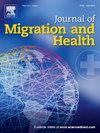Suicidality in first-generation, second-generation and non-immigrant youth in Canada
IF 2.9
Q1 PUBLIC, ENVIRONMENTAL & OCCUPATIONAL HEALTH
引用次数: 0
Abstract
Background
The number of people migrating globally has drastically increased in the last two decades and continues to rise. Although adult migrants are typically in better health than the population they migrate to, the evidence regarding migrant children's health, and especially their mental health, is mixed.
Objectives
To assess whether the prevalence of suicidal ideation and suicide attempt differs between first- and second-generation immigrant youth, compared to non-immigrants, and whether other sociodemographic factors moderate any associations.
Methods
We analyzed a subsample of youth aged 15–17 years from the 2019 Canadian Health Survey on Children and Youth – a national, representative, cross-sectional survey. We conducted multivariable logistic regression analysis, with past-year suicidal ideation and suicide attempt as outcomes and migrant status as exposure. We also investigated whether sociodemographic factors (including sex, family income, parental divorce) moderated these associations using interaction terms.
Results
Second-generation immigrants had almost twice the risk of first-generation immigrants and non-immigrants of having attempted suicide (OR 1.68, 95%CI: 1.07, 2.63). The association between second-generation immigrant status and suicide attempt was stronger among those not from low-income households (OR 2.04, 95%CI: 1.30, 3.21) and those with divorced parents (OR 5.19, 95%CI: 1.41, 19.12). The association between second-generation immigrant status and suicidal ideation was stronger among males (OR 1.78, 95% CI: 1.04, 3.07) and those with divorced parents (OR 4.13, 95%CI 1.40, 12.14). Additionally, some effects among first-generation immigrants varied by time since arrival.
Relevance
The healthy immigrant effect with respect to suicidality does not appear to pass from the first-generation to the second-generation. The magnitude of effect among second generation immigrant youth varies according to other sociodemographic factors.
加拿大第一代、第二代和非移民青年的自杀倾向。
背景:在过去二十年中,全球移民人数急剧增加,并将继续增加。虽然成年移徙者的健康状况通常比他们移徙到的人口要好,但关于移徙儿童健康,特别是心理健康的证据却参差不齐。目的:评估与非移民相比,第一代和第二代移民青年的自杀意念和自杀企图的患病率是否存在差异,以及其他社会人口因素是否会缓和任何关联。方法:我们分析了2019年加拿大儿童和青年健康调查中15-17岁青少年的子样本,这是一项全国性、代表性的横断面调查。我们进行了多变量logistic回归分析,以过去一年的自杀意念和自杀企图为结果,以移民身份为暴露。我们还调查了社会人口因素(包括性别、家庭收入、父母离婚)是否使用交互术语调节了这些关联。结果:第二代移民企图自杀的风险几乎是第一代移民和非移民的两倍(OR: 1.68, 95%CI: 1.07, 2.63)。非低收入家庭(OR 2.04, 95%CI: 1.30, 3.21)和父母离异家庭(OR 5.19, 95%CI: 1.41, 19.12)的第二代移民身份与自杀企图之间的相关性更强。第二代移民身份与自杀意念的关联在男性(OR 1.78, 95%CI: 1.04, 3.07)和父母离异的男性(OR 4.13, 95%CI 1.40, 12.14)中更强。此外,对第一代移民的影响因时间而异。相关性:健康移民对自杀的影响似乎不会从第一代传递到第二代。第二代移民青年的影响程度因其他社会人口因素而异。
本文章由计算机程序翻译,如有差异,请以英文原文为准。
求助全文
约1分钟内获得全文
求助全文
来源期刊

Journal of Migration and Health
Social Sciences-Sociology and Political Science
CiteScore
5.70
自引率
8.70%
发文量
65
审稿时长
153 days
 求助内容:
求助内容: 应助结果提醒方式:
应助结果提醒方式:


